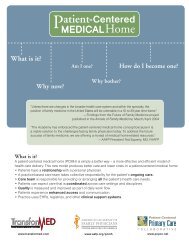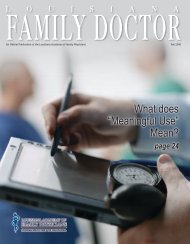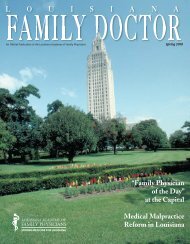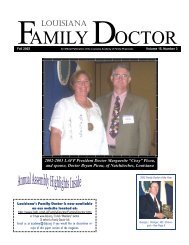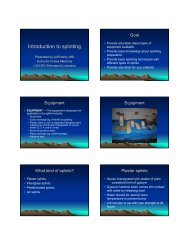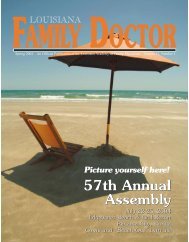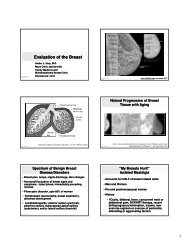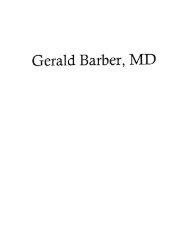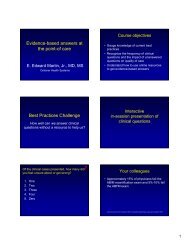New Drug Update 2009-2010 - LAFP
New Drug Update 2009-2010 - LAFP
New Drug Update 2009-2010 - LAFP
Create successful ePaper yourself
Turn your PDF publications into a flip-book with our unique Google optimized e-Paper software.
• Change the name of Maalox Total Relief to one that will not include the name "Maalox" and<br />
revise the graphics and information displayed on the front of the product container to help<br />
distinguish the active ingredients and uses of this product from the traditional Maalox antacids.<br />
• An educational program that includes outreach to healthcare professionals and consumers to<br />
inform them about the different products sold under the Maalox brand, including how to select the<br />
appropriate Maalox brand product.<br />
The company expects to begin selling the renamed product in September <strong>2010</strong>. Until that time,<br />
healthcare professionals and consumers should be aware of the following:<br />
• Maalox Total Relief contains the active ingredient bismuth subsalicylate and is used to treat<br />
diarrhea, upset stomach associated with nausea, heartburn, and gas due to overindulgence in<br />
food (overeating).Bismuth subsalicylate is chemically related to aspirin and may cause similar<br />
adverse effects such as bleeding. Bismuth subsalicylate has a warning statement stating that it<br />
should not be used in people who have or have a history of gastrointestinal ulcers or a bleeding<br />
disorder.<br />
• The traditional Maalox liquid products including Maalox Advanced Regular Strength and Maalox<br />
Advanced Maximum Strength are well-recognized antacid drug products that contain aluminum<br />
hydroxide, magnesium hydroxide, and simethiconeMaalox Total Relief should not be confused<br />
with traditional Maalox liquid antacid products.<br />
FDA is concerned about the public health impact of medication mix-ups with products that have the same<br />
names or portions of the same name but contain different active ingredients. The agency encourages<br />
drug companies to consider the potential for name confusion when choosing OTC product names.<br />
February 18, <strong>2010</strong> FDA <strong>Drug</strong> Safety Communication: <strong>New</strong> safety requirements for long-acting<br />
inhaled asthma medications called Long-Acting Beta-Agonists (LABAs)<br />
FDA notified healthcare professionals and consumers that, due to safety concerns, FDA is requiring a risk<br />
management strategy (REMS) and class-labeling changes for all LABAs. The REMS will require a revised<br />
Medication Guide written specifically for patients, and a plan to educate healthcare professionals about<br />
the appropriate use of LABAs. These changes are based on FDA's analyses of studies showing an<br />
increased risk of severe exacerbation of asthma symptoms, leading to hospitalizations in pediatric and<br />
adult patients as well as death in some patients using LABAs for the treatment of asthma.<br />
Healthcare professionals are reminded that to ensure the safe use of these products:<br />
• Single-ingredient LABAs should only be used in combination with an asthma controller<br />
medication; they should not be used alone.<br />
• LABAs should only be used long-term in patients whose asthma cannot be adequately controlled<br />
on asthma controller medications.<br />
• Pediatric and adolescent patients who require the addition of a LABA to an inhaled corticosteroid<br />
should use a combination product containing both an inhaled corticosteroid and a LABA, to<br />
ensure compliance with both medications.<br />
FDA has determined that the benefits of LABAs in improving asthma symptoms outweigh the potential<br />
risks when used appropriately with an asthma controller medication in patients who need the addition of<br />
LABAs. FDA believes the safety measures recommended will improve the safe use of these drugs.<br />
American Academy of Allergy, Asthma and Immunology (AAAAI) <strong>2010</strong> Annual Meeting. We are<br />
concerned with the FDA's recommendation that after asthma control has been achieved with a<br />
combination of LABAs and inhaled corticosteroids, LABA use should be stopped as soon as possible.<br />
“Their recommendations really run counter to our guidelines." They also state that combination therapy<br />
has been very effective, showing decreased morbidity, hospitalizations, and exacerbations. "The indices<br />
of safety that have been raised [by the FDA] really do not appear in the literature, and we really need to<br />
see new data before making dramatic changes in our recommendations." In addition, the AAAAI "does<br />
not want to see insurers or pharmacy benefit managers erecting more barriers because of this<br />
recommendation that will result in patients going out of control or becoming unstable before a physician<br />
or healthcare provider can continue their medication,"<br />
February 19, <strong>2010</strong> FDA approves Meningococcal (Groups A, C, Y, and W-135) Oligosaccharide<br />
Diphtheria CRM197 Conjugate Vaccine - Menveo<br />
For active immunization to prevent invasive meningococcal disease caused by Neisseria meningitidis<br />
serogroups A, C, Y and W-135 when administered to individuals 11 through 55 years of age.<br />
• Menveo consists of a liquid vaccine component (MenCYW-135 liquid conjugate component) and<br />
a lyophilized vaccine component (MenA lyophilized conjugate component). Reconstitute the<br />
11




